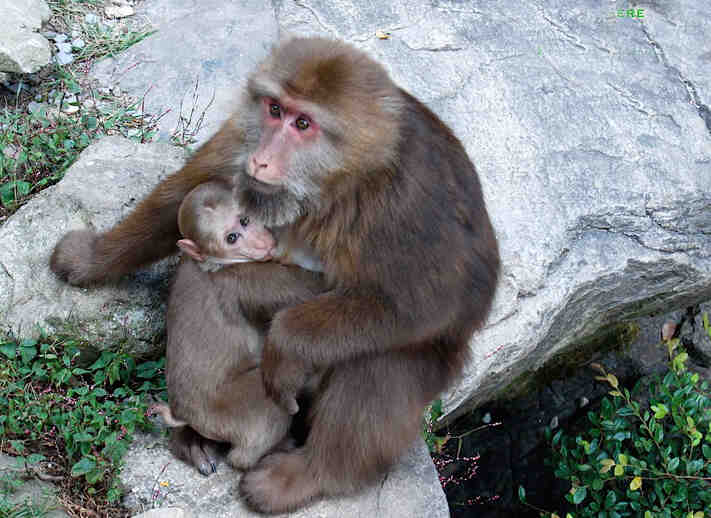Macaca arctoides
IUCN
LCBasic Information
Scientific classification
- name:Macaca arctoides
- Scientific Name:Stumptail Macaque,Short-tailed monkey, red-faced monkey, pile-tailed monkey, human bear,big green monkey
- Outline:Primates
- Family:Primates Cercopithecidae Macaca
Vital signs
- length:48-65cm
- Weight:7.5-10.2kg
- lifetime:20year
Feature
The face is often dark red or with purple patches, and the tail is surprisingly short, not even as long as the hind legs.
Distribution and Habitat
Origin: Cambodia, China, India, Lao People's Democratic Republic, Malaysia, Myanmar, Thailand and Vietnam.
Possibly extinct: Bangladesh.
Introduced: Hong Kong, China.
China is mainly distributed in the southwestern and southern China south of the Nanling Mountains and southern Fujian, including Yunnan, Guangxi, southern Guizhou, southern Jiangxi, southern Hunan, Guangdong and southern Fujian.
It mainly lives in tropical rainforests, monsoon forests, monsoon evergreen broad-leaved forests, deciduous broad-leaved forests and mixed coniferous and broad-leaved forests in mid-mountain areas. The habitat altitude can range from coastal lowlands to mid-mountain forest areas at an altitude of 2,650 meters. It lives in the higher altitude forest belts of high mountain dense forests, mainly using the evergreen broad-leaved forest belt and the evergreen and deciduous mixed forest belt. In addition, there must be mountain stream water sources and steep cliffs in its habitat for th
Appearance
The short-tailed macaque is a large macaque with a broad face, a relatively wide skull, and a distinct brow ridge. The body is round and simple, with strong limbs. The forehead is bare and hairless, and almost completely bald, gray-black in color, and the hair on the cheeks is relatively sparse. The hair on the chest, abdomen, and the inside of the limbs is sparse and lighter in color, and the hair on the shoulders, neck, and back is relatively rough. The area around the callus is also bare and hairless. The tail is surprisingly short, not even as long as the hind legs, only one-tenth of the body length, and the hair is sparse, so it is also called "stubborn monkey".
The hair on the top of the head of the adult short-tailed macaque is longer, spreading from the center to the sides. The whiskers on the cheeks and under the chin are like sideburns, and the chin whiskers under the lips are dark brown and the surrounding brown-white are in a clearly layered half-moon shape. Th
Details
The macaque is a larger species of macaque that is endemic to South and Southeast Asia.

The appearance of the macaque is so similar to that of the Tibetan emirate that many books confuse them with each other, and some people think that they belong to different subspecies of the same species. However, there are many obvious differences between them. For example, the short-tailed monkey is smaller than the Tibetan emirate, has longer and sparse body hair, and is dark brown or chocolate in color. Therefore, it is commonly known as "black monkey" or "black monkey" in South China. "Mud Monkey". In addition, the genitals of male macaque monkeys are also unique. The penis is flat and long, spear-shaped, about 40 mm in length, and it also emits an unpleasant moss smell. However, the most striking feature that distinguishes the short-tailed monkey from the Tibetan emirate is that the faces of adults all have bright red patches. Some older individuals also turn to purple-red or black-red, so they are also called red-faced short-tailed monkeys. Red-faced monkey, red-faced monkey, etc.
Macaques like to live in groups, with the number of each group ranging from 10 to 30, sometimes as many as 80. Compared with other macaques in China, they are more ground-dwelling, especially when frightened, they often flee along the ground.
The main reasons affecting the survival of this species are: habitat destruction, including logging, charcoal burning, building roads, dams, laying power lines and fisheries, as well as arson, habitat fragmentation, and soil erosion. The animals are hunted and traded for food, traditional "medicine" and local bone goods, meat and pet animals. Died accidentally during the trafficking process.
It is listed in the 2013 Red List of Endangered Species of the World Conservation Union (IUCN) ver 3.1 - Vulnerable (VU).
It is listed as a Class II protected animal in CITES under the Washington Convention.
It is listed as Level 2 in the "List of National Key Protected Wild Animals in China".
Protect wild animals and eliminate wild game.
Maintaining ecological balance is everyone’s responsibility!








